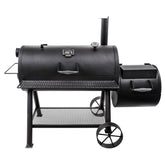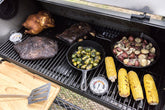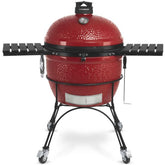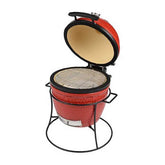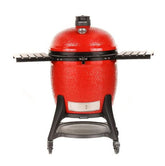How to smoke meat at home: Easy guide for beginners
Smoking meat at home isn’t just a cooking method - it’s a journey into rich flavors, tender textures, and backyard BBQ mastery. Whether you're using a simple charcoal grill or a fancy electric smoker, learning how to smoke meat the right way unlocks a whole new world of taste. In this guide, you'll discover everything from setting up your smoker to choosing the best wood and avoiding rookie mistakes. Stick around till the end, because we’ll share the top secrets even seasoned pitmasters swear by - plus, a quick-reference table to help you pick the perfect wood for every meat. Let’s fire it up.

1. What is meat smoking?
Smoking meat is a low-and-slow cooking method that infuses rich, smoky flavor deep into the meat while keeping it juicy and tender. Unlike grilling, which uses high heat for fast cooking, smoking relies on indirect heat and wood smoke to slowly transform cuts of meat into mouthwatering perfection. It’s not just about flavor - it’s about the experience. From the anticipation as smoke builds to the satisfaction of slicing into perfectly smoked ribs or brisket, smoking meat is a craft worth learning. Whether you're preparing a weekend feast or simply want to impress your family, mastering this technique will level up your home cooking game.

2. Must-have equipment to start smoking meat at home
To create mouthwatering, smoky meat right at home, the first and most important step is having the right tools in place. With proper preparation, the entire process becomes smoother, more enjoyable, and incredibly rewarding.
If you're already a seasoned BBQ enthusiast, choosing a smoker might be second nature – you can turn almost any grill into a smoker that suits your needs. But if you're a beginner, it's best to go with a dedicated smoker designed for ease of use and great results.
Here are some popular options to consider:
-
Charcoal offset smoker - Delivers authentic, traditional BBQ flavor using real wood and charcoal.
-
Pellet smoker - A modern choice with smart temperature control via mobile app, ideal for beginners.
-
Reverse flow offset smoker - Perfect for those who prefer a richer, smokier flavor profile.
You can browse various models at X-BBQ Store to find the one that fits both your needs and your budget.
Another key to great smoked meat is choosing the right wood. For beginners, oak is highly recommended. It’s affordable, has a mild smoke flavor, and doesn’t overpower the natural taste of your meat. As you gain more experience, try branching out into richer wood flavors like cherry, hickory, or apple for more depth and variety.
Don’t forget about supporting tools like aluminum foil or a cast iron pot that’s oven-safe. Based on X-BBQ’s experience, wrapping your meat or placing it in a cast iron pot at low temperatures near the end of the smoking process helps retain moisture and keeps the meat juicy. Cast iron is also a cost-effective choice since it can be reused multiple times.
Once all your gear and ingredients are ready, it’s time to dive into the actual smoking process. This is where the fun begins – an exciting journey that opens up a whole new world of rich, smoky flavors you’ll love.
3. Best meats to smoke for beginners
In Texas – the heartland of American BBQ – the smoking method was born out of necessity and creativity, designed to transform tough cuts of meat like brisket into something extraordinary. Brisket comes from the cow's chest, a cut known for its dense connective tissue and chewy texture, making it difficult to enjoy with conventional cooking methods.

Texans mastered the art of low and slow smoking, using wood smoke over long hours at low temperatures to break down the tough collagen in the meat. The result? A tender, juicy, flavorful brisket that practically melts in your mouth, infused with the deep, smoky essence that defines Southern BBQ.
However, if you're short on time or new to smoking, chicken wings are a fantastic alternative. They’re smaller, absorb flavor quickly, and require much less smoking time – perfect for beginners looking to enjoy rich, smoky flavor without the long wait or complex process.

4. Step-by-Step: How to smoke meat at home
Smoking meat at home might sound intimidating at first, but once you get the hang of it, it’s an incredibly rewarding process that delivers rich, deep flavor unlike any other cooking method. Whether you're working with brisket, ribs, chicken wings, or pork shoulder, the basics remain the same. Here's a step-by-step guide to help you get started:
4.1 Step 1: Choose your meat
Pick your protein based on your experience level and the time you have:
-
Beginners: Chicken wings, thighs, or drumsticks – cook quickly and absorb smoke well
-
Intermediate: Pork ribs or pork shoulder – more fat and connective tissue to break down.
-
Advanced: Beef brisket – requires long hours but yields incredible flavor and texture.
4.2 Step 2: Prepare the meat
Trim excess fat, then season your meat with a dry rub or marinade. A basic dry rub can include:
-
Salt
-
Black pepper
-
Paprika
-
Garlic powder
-
Brown sugar (optional)
Let the meat sit for at least 30 minutes or refrigerate overnight for deeper flavor.
4.3 Step 3: Choose the right smoker & wood
Select a smoker that suits your skill level and setup:
-
Offset or Reverse Flow Smoker: Ideal for traditional smoking.
-
Pellet Smoker: Great for precise temperature control (smartphone-connected).
-
Electric or Kamado Grill: Simple and consistent for beginners.
For wood:
-
Beginner: Oak – neutral, forgiving flavor.
-
Flavorful Options: Apple (sweet), Cherry (mild), Hickory (strong), Mesquite (very strong – use sparingly).
4.4 Step 4: Set up your smoker
-
Preheat your smoker to 225–250°F (107–121°C).
-
Place wood chunks or pellets into the smoker box or firebox.
-
Add a water pan inside the smoker to help regulate temperature and keep the meat moist.
4.5 Step 5: Start smoking
-
Place the meat on the grill grates away from direct heat (indirect cooking).
-
Close the lid and let the smoke do the work.
-
Keep the lid closed as much as possible – every time you open it, you lose heat and smoke.
Use a meat thermometer to monitor internal temperature:
-
Chicken: 165°F (74°C)
-
Pork shoulder: 195–203°F (90–95°C)
-
Brisket: 200–205°F (93–96°C)
4.6 Step 6: Wrap (Optional)
For larger cuts like brisket or pork shoulder, you can wrap the meat in foil or butcher paper once it reaches about 160°F (71°C) to prevent it from drying out. This is called the "Texas Crutch" and helps push it through the “stall” (when the internal temp plateaus for hours).
5. Common mistakes to avoid when smoking meat
Smoking meat is a rewarding process, but even experienced pitmasters can slip up. If you're just starting out, avoiding these common mistakes can save you time, frustration, and a ruined cut of meat. Here’s what to watch out for:
5.1 Rushing the process
Smoking is a low and slow cooking method. Trying to speed things up by increasing the temperature will only dry out the meat or make it tough. Be patient — great BBQ takes hours, not minutes.
5.2 Not using a thermometer
Never guess if the meat is done. Always use a digital meat thermometer to monitor internal temperature. Relying on time alone can lead to undercooked or overcooked meat.
5.3 Using too much wood
More smoke doesn’t always mean more flavor. Over-smoking can result in a bitter, harsh taste. Start with a moderate amount of wood and learn how each type affects flavor.
Tip: Thin, blue smoke is ideal — not thick white or black smoke.
5.4 Opening the lid too often
It’s tempting to check on your meat constantly, but opening the lid releases heat and smoke, causing fluctuations in temperature. Trust your setup and check only when necessary.
5.5 Skipping the resting time
Resting meat after it comes off the smoker is crucial. It allows juices to redistribute, making the meat juicier and more flavorful. Skip this step, and your brisket or ribs could turn dry.
5.6 Starting with complicated cuts
Beginners often go straight for brisket — one of the hardest cuts to master. Instead, start with something simpler like chicken wings, pork ribs, or sausages to build confidence.
5.7 Using lighter fluid or treated wood
Never use lighter fluid, treated wood, or softwoods like pine. These release harmful chemicals and give your meat an unpleasant flavor. Stick with hardwoods like oak, apple, hickory, or cherry.
5.8 Not controlling temperature consistently
Smoking meat requires maintaining a steady temperature — typically between 225–250°F (107–121°C). Wild temperature swings can ruin texture and flavor. Use dampers, vents, or digital controls to manage heat.
5.9 Ignoring the water pan
The water pan helps regulate temperature and keeps meat moist during long smokes. Don’t skip it, especially for large cuts. It also helps maintain consistent cooking conditions.
5.10 Not cleaning your smoker
Built-up grease, ash, and old food can affect the flavor of your next cook and create flare-ups. Clean your smoker regularly to keep it running smoothly and your food tasting fresh.
5.11 Bonus mistake: Not enjoying the process
Smoking meat is as much about the experience as the result. Enjoy the aroma, the anticipation, and the ritual. Invite friends, share stories, and turn it into something you look forward to every time.
6. Conclusion
Smoking meat at home is a rewarding skill that transforms everyday cuts into tender, flavorful masterpieces packed with smoky goodness. With the right equipment, a bit of patience, and some simple techniques, anyone can become a backyard pitmaster. Remember to choose the right meat, maintain steady temperatures, use quality wood, and most importantly, enjoy the process—from prep to the final delicious bite. Now that you know the essentials, it’s time to fire up your smoker and impress your family and friends with mouthwatering smoked meats. Don’t forget to bookmark this guide and come back for more BBQ tips and recipes. Happy smoking!

